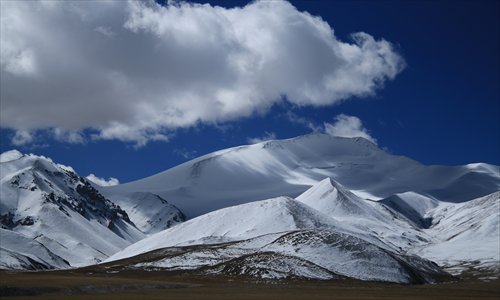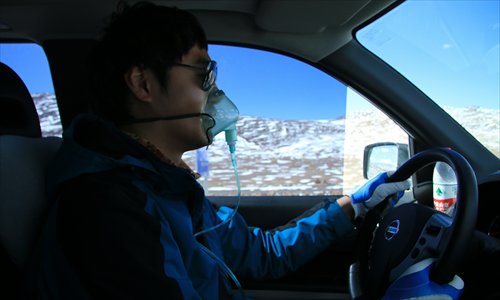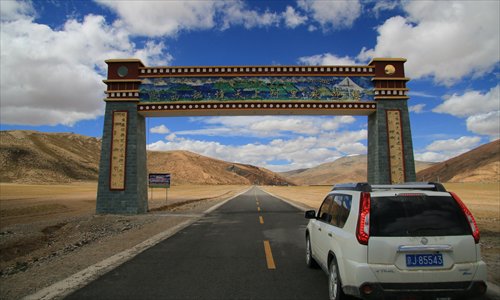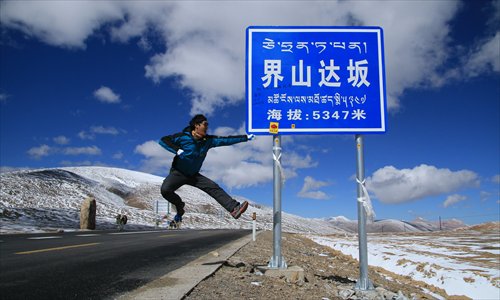A road in the sky
The dusty highway between Tibet and Xinjiang is unlike any other in the world

A view of mountain ranges from Yang's vehicle while travelling on the G219. Photo: Courtesy of Yang Shuo
Acute altitude sickness. Swirling windstorms. A no man's land.
These are not deterrents, but the incentives that attract travelers to journey through China National Highway 219, a 1,455-kilometer stretch of road between Yecheng in Xinjiang Uyghur Autonomous Region and Shiquanhe township in Tibet Autonomous Region along China's western border.
The road is long and arduous, and concerns over civil unrest in Xinjiang in recent years mean that the destination for those traveling north may just be as fraught with difficulty as the journey itself. Yet intrepid travelers are not dissuaded, for to travel along the highway - the highest in the world - is to get a glimpse of places unlike any others in the world.

The carcass of an animal lying on a stretch of road known as "the valley of the dead." Photo: Courtesy of Yang Shuo
Life in the highlands
Also known as the "Sky Road" in Chinese, construction on the China National Highway 219 (G219) began in 1951, and was completed in 1957. Parts of the road were originally no more than gravel and dust, but the entire highway was repaved last year with asphalt.
Putting aside considerations of where one is traveling from, most travelers going to Tibet will choose the National Highway 318 (G318), which connects Chengdu in Sichuan Province to Lhasa in Tibet. The G318 is well-known for idyllic views of mountains, rivers, grasslands and forests along the route.
Those who take the G219 are usually the ones who inhabit a spirit of adventure. Besides taking travelers through far more solitary plains than on the G318, the G219 also lays claim to having the highest section of road in the world, at a vertigo-inducing 5,248 meters above sea level at Jieshan Daban in Ritu county, according to a Xinhua report.
Travelers are known to have to wear oxygen masks during this stretch, to deal with altitude sickness.
"It's been a lifelong dream of mine to ride [my motorcycle] through the G219, which is known as the most challenging stretch of road in China," said Li Jian, 61.
A retired doctor, Li finally made the trip through the infamous stretch of road with two friends in July.
"I wanted to know what it felt like to ride at such high altitude," said Li. "Roads are made to be traveled."
Despite its reputation for running through terrain that is by and large uninhabited, the G219 does pass through a number of important historical and religious sites.
The portion of the road that stretches across Ngari Prefecture passes Mount Kailash and Lake Manasarovar, which are sites of pilgrimage for Hindus and Buddhists. Near Mount Kailash are also the ruins of the ancient Guge Kingdom, dating from roughly the 10th century AD.
"Lucky travelers will be able to spot Tibetan antelopes, though most of them dart away when they are approached by people," said Li. "It was tiring, but I think I have a better idea now of what life is like in the highlands."

Travelers through the G219 often wear oxygen inhalers to deal with the high altitude.Photo: Courtesy of Yang Shuo
No man's land
Several stretches of the road is known to many as "no man's land."
Perched more than 5,000 meters above sea level, the terrain here is harsh, and there are few signs of life, other than the odd Tibetan antelope, wolf or other wild animal .
"It's just desert on all sides," said Li. "Sometimes, the winds were so strong that we were worried our motorcycles would be swept off the road."
Yang Shuo, 31, drove through the stretch in an SUV with two friends earlier this month.
"For miles and miles, it was difficult to see a single other soul. It was surreal," he said. "I had to make sure we had enough petrol, because there are hardly any gas stations along this stretch."
Within this no man's land is a place called Sirengou, which translates literally as "the valley of the dead." According to a Xinhua news report, construction workers and travelers have died there as a result of altitude sickness, and are buried along the stretch of road between Jieshan Daban and Dahongliutan areas.
Liu Tuo, 24, a postgraduate student at the Peking University, decided to hitchhike through the area in July last year.
"There are no coaches running through no man's land," said Liu.
Liu was able to hitch rides from truck drivers who were required to carry their lorries through the region. Often, he would find other backpackers already in the vehicles when he got into the cars.
"Most of the drivers were Uyghur or Tibetan people. Although they didn't speak much Chinese, they were willing to give us a ride," he said.

An ornamental gate, marking the entrance into Ngari Prefecture in Tibet. Photo: Courtesy of Yang Shuo

Yang Shuo, an intrepid traveler, strikes a pose at a road sign for Jieshan Daban area on the China National Highway 219 in the far west of Tibet. The section lays claim to being the highest road in the world. Photo: Courtesy of Yang Shuo
Not for the faint of heart
Travelers going to Xinjiang who are not put off by the potential hazards of traveling on the G219 must still consider the safety of the destination where they are traveling.
In recent years, the region of southwestern Xinjiang at which the highway ends has been witness to a number of violent attacks arising from tensions in the region. Yecheng county, where the road ends, is home to 500,000 mostly Uyghur people, with Han people making up only 6 percent of the population.
Xinhua reported that in July, 13 attackers were shot dead by police after ramming a car into a police station and detonating explosives, and in 2012, seven perpetrators were shot dead by police after 13 civilians were fatally stabbed.
"I was hesitant when I was making my itinerary, because [the G219] leads into southwestern Xinjiang," said Yang. "But we decided to just set off, and assess the situation along the way."
To Yang's surprise and relief, he found that the people he encountered on the road and when he arrived in Xinjiang were friendly and accommodating.
"I had seen images on television of terrorists in Xinjiang, so at first, I was a bit wary," he said. "But when I put on my Xinjiang hat, and started playing the Xinjiang drums with them, I realized they were very warm and friendly."
Li also found the local people living in Yecheng county to be very hospitable.
"When we arrived, it started raining. The locals said that we must be good luck talismans, because we had brought the rain to a place that usually experiences long periods of draught."